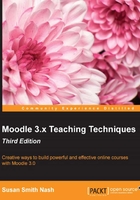
The Moodle advantage
Many of the features in Moodle are carefully chosen to support a philosophy of learning called social constructionist pedagogy. Simply stated, this style of learning and teaching is based on four concepts: constructivism, constructionism, social constructivism, and connected and separate:
- Students acquire new knowledge as they interact with their environment, your course activities, and other students.
- Students learn more when they construct learning experiences for others. You might be familiar with the process of learning described by Jerome Bruner in his Learning Pyramid. It states that students remember 10% of what they read, 20% of what they hear, 30% of what is demonstrated to them, 50% of what they discuss, and 75% of what they practice. This pyramid states that students retain 90% of what they teach others. You can check the learning pyramid at http://homepages.gold.ac.uk/polovina/learnpyramid.
- When students become part of a culture, they are constantly learning. For example, you and your partner would probably learn more about ballroom dancing when you're in a dance class versus watching a video together. The interaction with other students, and possibly a variety of teachers, would enrich and accelerate your learning process.
- Some students try to remain objective and factual, some try to accept more subjective views, and others try to integrate both approaches. Constructed behavior is when a student can choose whichever approach is more appropriate.
You are probably not accustomed to an application's features being chosen based on a philosophy. Usually, features are chosen based only on what is technically feasible and what customers are willing to pay for. These are certainly factors to consider for Moodle developers. However, the educational philosophy behind Moodle is also a criterion for adding features. This gives Moodle a tremendous advantage.
As Moodle is designed around a well-defined educational philosophy, its user interface is very consistent. I don't just mean in the traditional sense, where you compare icons, colors, menu actions, and layouts on each page to ensure that they match, but as you go through a Moodle site, things look, feel, and function consistently. More importantly, you interact with each activity, your classmates, and the teacher in a consistent way, whether it's in a chat room, forum, or by leaving feedback for a Workshop. When interaction becomes easier, a student can focus more on learning and less on the software.
Further, Moodle's interactive activities and features allow developers to create courses that are self-guided and self-paced and can be utilized with mobile devices as well as desktop computers.